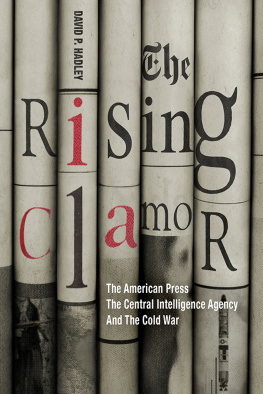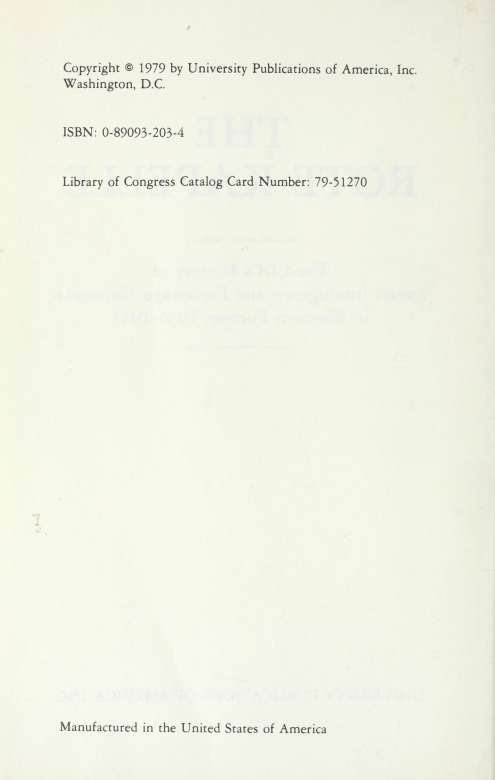This book made available by the Internet Archive.
TABLE OF CONTENTS
Page
INTRODUCTION xi
Diagram of the Rote Kapelle xiv
PART ONE
Narrative History of the Rote Kapelle
BELGIUM
Chronology 1
Diagrams
The Trepper Group 1938-1940 8
The Sukolov Group 1940-1941 9
The Jeffremov Group September 1939- May 1942 10
The Jeffremov Group May 1942-August 1942 11
Narrative 13
Early Development 13
Leopold Trepper 15
The Foreign Excellent Raincoat Company 16
Trepper's Documentation 18
Mikhail Makarov 20
Victor Sukolov 21
Konstantin Jeffremov 22
Communications 23
The German Invasion 24
Simexco 25
The First Arrests 27
Reorganization 28
vi Contents
The Second Arrests 28
The German Version 30
The Playbacks 37
Translation of Statement by Abraham Rajchmann
Introductory Note 38
Contacts with Grossvogel 1934-1939 38
Services for the Trepper Network 1939-1940 39
Flight to France 1940 42
Services for the Sukolov Network 1940-1942 43
Services for the Jeffremov Network 1942 47
Arrest and Collaboration 1942-1944 50
HOLLAND
Chronology 57
Diagram
The Winterink Group in Holland 63
Narrative 65
Background 65
Anton Winterink 66
Daniel Gouwlooze and the Dutch Information
Service 69
The Emigre Group of Alfred Knochel 71
The Liquidation of the Gouwlooze Group 72
|
FRANCE
Chronology 73
Diagrams
The Rote Kapelle in France in 1940-1944 78
Group "Andre" 79
The Cover Firm (Simex) 80
The "Professor" and "Arztin" Groups 81
The "Harry" Group 82
Lyons Group 83
Marseilles Group 84
The Ozols Network 1940-1944 85
Narrative 87
Leopold Trepper 87
Simex 88
The Seven Networks 89
Finances 90
Henri Robinson 92
The Robinson Papers 96
Communications 101
Victor Sukolov 104
Trepper's Arrest 105
The Playback 106
Trepper's Escape 109
An Evaluation of the Playback Ill
The Ozols and Mithridate Networks 117
Jean Claude Spaak 122
The Return to Moscow 128
GERMANY
Chronology 131
Diagrams
The Schulze-Boysen Group 136
The Harnack Group 137
The Von Scheliha Group 138
Narrative 139
Background 139
The Schulze-Boysen Group 140
The Harnack Group 146
The Von Scheliha Group 150
The Role of Victor Sukolov 153
The Communist Underground Group of
Anton Saefkow 155
The Arrests and Trial 159
Postscript 163
viii Contents
SWITZERLAND
Chronology 165
Diagrams
The Rote Drei 169
The "Sissy" Group 170
The "Long" Group 171
The "Pakbo" Group 172
Narrative 173
The Radio Messages Examined 173
Vera and the Beginnings of the Red Three 174
Sonia 175
Sissy and Paul 175
Sissy's Fight with Moscow 180
Dora 182
Lucy and Taylor 184
Lucy's Sources in World War II 185
General Hans Oster 185
Hans Bernd Gisevius 189
Ex-Chancellor Josef Wirth 189
Carl Goerdeler 192
The Unknown Boelitz 193
Sissy's Other Sources , 193
Long 199
Agnes 199
Kurz 201
Grau 203
Rot 203
Feld 205
The Background of Josef Wirth 205
Pakbo 209
Jim 211
The Structure of the Rote Drei 212
The Role of Karel Sedlacek 212
Vladimir Sokolin 217
Phase II: Lucy's Post-War Operation 218
The Return of Agnes 220
Dr. Werner Thormann 220
Professor Max Horkheimer 220
Lucy the Mercenary 222
The Peddlers 222
The Stage and the Actors 224
THE ROTE KAPELLE ELSEWHERE
Austria 227
Bulgaria 228
Canada 229
Czechoslovakia 230
Italy 231
Poland 232
Portugal 232
Rumania 233
Scandinavia 233
Yugoslavia 234
PART TWO
Modus Operandi of the Rote Kapelle
General 237
Cover and Security 239
Finances 242
Motivation 243
Documentation 245
Contacts and Personal Meetings 245
Communications 248
Conclusion 252
x Contents
PART THREE
Personalities
Personality Sketches 255-390
INTRODUCTION
The term "Rote Kapelle" ("Red Orchestra," "Red Band," "Red Choir," or "Red Chapel") was a cryptonym coined by the German central security office, the Reichssicherheitshauptamt (RSHA), to designate the Soviet networks of espionage and subversion discovered in Western Europe after the outbreak of the Russo-German war in 1941. The espionage reports were transmitted primarily by radio. The "music" on the air had its pianists (radio operators), a maestro in the field (the Grand Chef), and its conductor in Moscow (the Director). This analogy was not new to German counterintelligence. "Kapelle" was, in fact, an accepted Abwehr term for secret wireless transmitters and the counterespionage operations against them. The term "Rote Kapelle" was originally applied only to the secret operation started by Ast 1 Belgien (Abwehr III F.) 2 in August 1941 and conducted against a station of the Soviet intelligence service which had been detected in Brussels by the Funkabwehr (W/T intercept and cryptanalytic component of German military counterintelligence). The investigation, however, soon extended into Holland, Germany, France, Switzerland, and Italy; and the designation "Rote Kapelle" was adopted for these expanded operations also.
In July 1942 the investigation of the Rote Kapelle was taken over from Ast Belgien by Section IV. A.2. of the Sicherheitsdienst (SD, the security service of the RSHA). After the arrest of the two leading Russian agents, Leopold Trepper and Victor Sukolov, a small independent Gestapo 3 unit, "Sonderkommando 4 Rote Kapelle," was
1 Ast: abbreviation of Abwehrstelle, a major field office of the Abwehr, the German military counterintelligence service.
2 Abwehr III F.: Section III (counterintelligence) working against the intelligence services of the enemy.
3 Gestapo: Geheime Staatspolizei, or Secret Federal Police.
xii Introduction
formed in Paris in November 1942. There has been some misunderstanding about the term "Rote Kapelle" because it was also used to denote this special counterespionage group of the Gestapo, which was responsible for penetrating the Soviet apparatus and doubling its agents. As commonly used, therefore, the term "Rote Kapelle" could mean both the Soviet networks and the branch of the GIS responsible for combatting these agents. In the course of this study the term "Rote Kapelle" will be used exclusively to designate the Soviet networks. The term "Sonderkommando" will be used to designate a German counterespionage group.

















